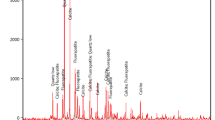Abstract
Four big head phosphate samples (about 200 kg) were collected from West Sibaiya mines [medium grade (sample 1, southern mine), high grade (sample 2, the mine in the cultivated area), low grade (sample 3, oversize), and tailings (sample 4) phosphate ores]. The representative samples were analyzed chemically for P2O5, Fe2O3, Al2O3, InR, CaO, MgO, TiO, MnO, SO 2−4 , F−, Cl− loss on ignition (LOI), and U before and after screen analysis (−10.0 +9.50, −9.50 +6.70, −6.70 +2.0, −2.0 +1.0, −1.0 +0.85, 0.85 +0.710, −0.710 +0.500, −0.500 +0.350, −0.350 +0.250, −0.250 + 0.180, −0.180 +0.125, −0.125 +0.075, and −0.075-mm-size fractions). The different grades of phosphate ores (organogenic-granular phosphorite ores with carbonates, calcite, calcedony, etc.) were beneficiated using local crude rice bran oil and imported oleic acid (individuals) as collectors, NaOH or KOH as the pH adjustor, and Na2SiO3 as the silica depressant. The results indicate that −0.355, +0.180 mm grain size, pH=9.6, 20 minutes conditioning time, 0.7 kg Na2SiO3 (depressant)dose/ton feed ore, 4.25 kg rice bran oil dose/ton feed of phosphate ore or 3.4 kg oleic acid (collector) dose/ton feed of phosphate ore, and cleaning (reflotation) of phosphate concentrates are the optimum conditions for beneficiation of Sibaiya phosphate ores. On cleaning (reflotation) the phosphate ore feeds of samples 1 (medium, P2O5=28.67 pct), 2 (high, P2O5=31.70 pct), 3 (oversize, P2O5=25.30 pct), and 4 (tailings, P2O5=22.61 pct)using rice bran oil as a collector, the feeds beneficiate into concentrates of P2O5 pct equal to 31.87, 34.70, 26.16, and 31.90 pct (recoveries equal 49.41, 61.41, 52.01, and 29.03 pct P2O5) for samples 1, 2, 3, and 4, respectively. On using oleic acid as a collector, P2O5 pct in phosphate feeds of samples 1, 2, 3, and 4 increases (upgrades) into 31.28, 33.95, 26.82, and 30.70 pct in concentrates (recoveries equal 61.74, 53.60, 53.31, and 36.30 P2O5). Comparing the results obtained on using rice bran oil and oleic acid as collectors from the economic point of view, the costs of producing 1 ton phosphate concentrate by rice bran oil are lower (∼LE 70) than those on using oleic acid (∼LE 100) as a flotation collector.
Similar content being viewed by others
References
G.I. Spanderoshvilli and M. Mansour: “The Egyptian Phosphates from Studies on Some Mineral Deposits of Egypt,” Geological Survey, Cairo, Egypt, Article 6, pp. 89–104, 1970.
M. Ghanem, A.A. Zalata, T.M. Abdel Razik, M.S. Abdel Ghani, I.A. Mikhailov, A.V. Rozaliaev, and Y.V. Mirtov: “Studies on Some Mineral Deposits of Egypt,” Geological Survey, Cairo, Egypt, Article 8, pp. 109–131, 1970.
H. Soto and I. Iwasaki: Int. J. Mineral Process, 1996, vol. 16 (1–2), pp. 3–16.
I. Anazia and J. Hanna: Int. J. Mineral Process, 1986, vol. 23 (3–4), pp. 311–14.
Q. Wang and K. Heiskanen: Mineral Eng., 1990, vol. 3 (5), pp. 473–81.
R.M. Awadallah: Master’s Thesis, Assiut University, Assiut, Egypt, 1971.
“Pilot Scale Beneficiation Plant for West Sibaiya Phosphate,” Design Report, Equipment, Processes, Operation and Data Collection, Abu Zaabal Company for Fertilizers and Chemicals, West Sibaiya, Edfu, Egypt, 1979.
Author information
Authors and Affiliations
Rights and permissions
About this article
Cite this article
Awadallah, R.M., Mohamed, A.E., El Hazek, N.T. et al. Beneficiation of west sibaiya phosphate ores by flotation in alkaline media. Metall Mater Trans B 29, 1149–1156 (1998). https://doi.org/10.1007/s11663-998-0036-8
Received:
Issue Date:
DOI: https://doi.org/10.1007/s11663-998-0036-8



